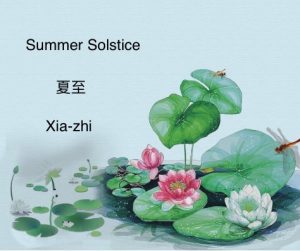
Xia-zhi (noun) 夏至 (Chinese): Summer Solstice (10th solar term), literally in Chinese “xia” 夏 = summer, “zhi” 至 = extreme
Example:
In the ancient Chinese agriculture calendar, Xia-zhi is the 10th solar term out of the 24 solar terms in a year. Xia-zhi marks the summer solstice when the Sun reaches its highest position in the sky and is the day with the longest period of daylight. Xia-zhi begins when the Sun reaches the celestial longitude of 90° and ends when it reaches the longitude of 105°. Xia-zhi more often refers in particular to the day when the Sun is exactly at the celestial longitude of 90°. Xia-zhi is the first solar term recognized among the 24 solar terms. In the seventh century BC, the ancestors determined the summer solstice by using a simple primitive device 土圭 (tu-qui), “a pole on a template”, now known as a Sundial, to measure the sun shadow. Xia-zhi usually occurs between June 20 and June 23 depending on the location of the globe.
There are three periods in Xia-zhi: In the first period 鹿角解, antlers start to cast off. In the second period 蝉始鸣, Cicadas begin to chirp. During the third period 半夏生, ban-xia “Pinellia ternata” (a Chinese herb medicine) start to grow. In Chinese, “ban” 半 = half, “xia” 夏 = summer. On Xia-zhi, daylight lasts the longest for the whole year in the northern hemisphere. After Xia-zhi, daylight hours get shorter and shorter and temperatures become higher in the northern hemisphere. There is an old saying in Chinese: “Eat dumplings on the Winter Solstice and eat noodles on Summer Solstice.” During Xia-zhi, Chinese people have a tradition of eating noodles or chilled noodles.
Since ancient times, Xia-zhi has been a solar term for agricultural purposes in the lunar calendar. Xia-zhi is still remembered and celebrated as a Chinese traditional festival.
